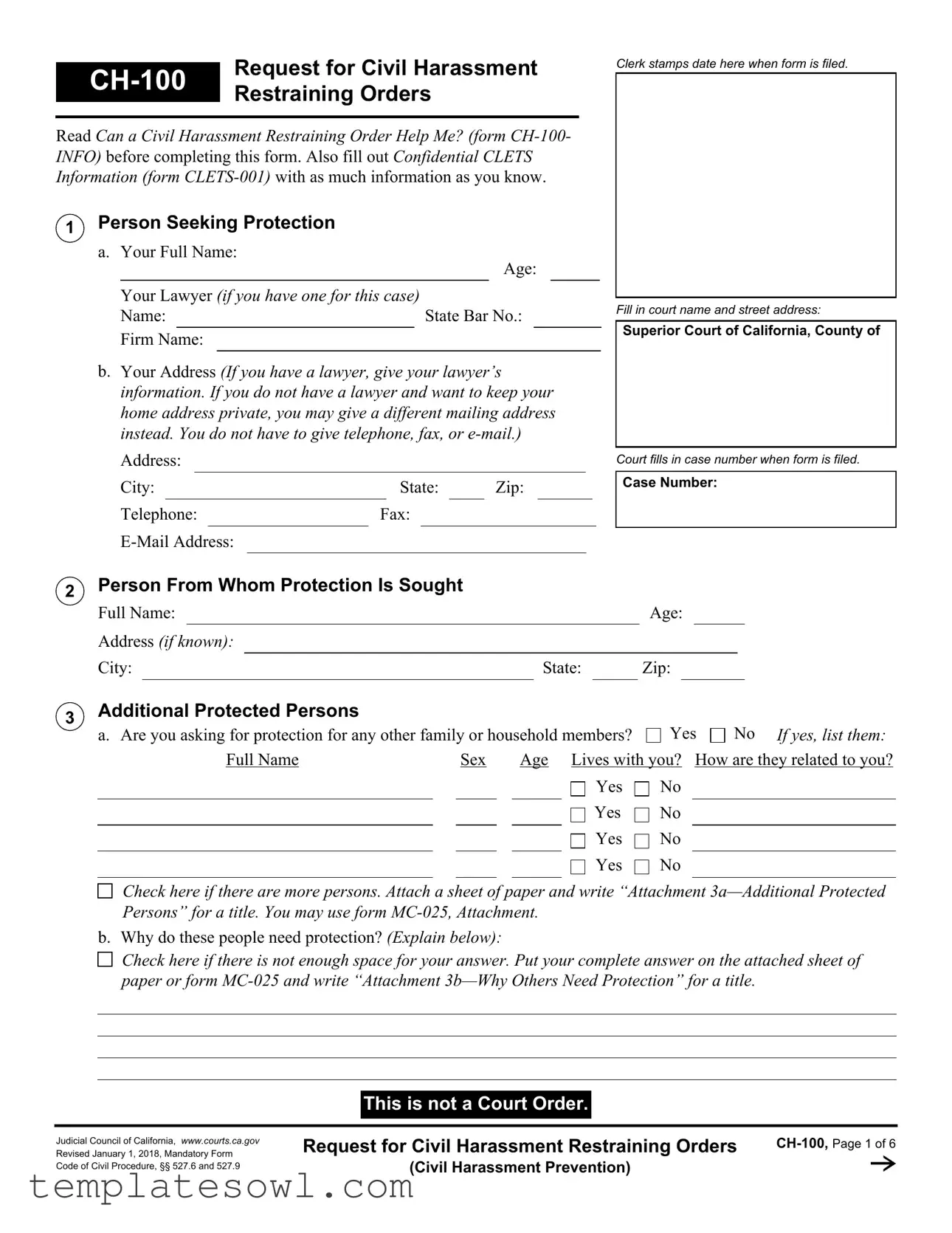Filling out the Restraining Order CH 100 form can be daunting, and mistakes can lead to delays or dismissals. One common error is failing to read the accompanying instructions. The Request for Civil Harassment CH-100 form is just the start; the information sheet, CH-100-INFO, provides essential guidance that can help avoid pitfalls. Ignoring this document can cause applicants to miss critical points about their rights and the requirements for the form.
Another frequent mistake involves incomplete personal details. When filling in your information, ensure that every section is complete. Omitting your full name, age, or contact information can result in a rejection. Your lawyer's contact details should also be accurate if you have legal representation. Missing such details can slow down the process significantly or even invalidate your request.
Additionally, people often forget to provide sufficient information about the individual from whom they seek protection. Listing their full name, age, and last known address is vital for the court's understanding. A vague or incomplete description of the harasser can hinder the court's ability to process your request effectively.
Applicants commonly misjudge the importance of detailing all additional protected persons. If you seek protection for family or household members, you must list their names, ages, and relationships to you accurately. Without this, the court may disregard their need for protection, putting them at risk.
Furthermore, when explaining the harassment, many fail to provide specific details. A brief summary is often not enough. It's crucial to detail the incidents, including dates, context, and the impact on your life. This information helps the court understand the gravity of the situation. If you run out of space, use the provided attachments wisely.
Another mistake is neglecting to indicate all relationship types between you and the person from whom you're seeking protection. This section is vital in explaining the context of the harassment. An unclear relationship can lead the court to misunderstand your situation, which could be detrimental to your case.
Many applicants also forget to check all relevant boxes regarding prior court cases or existing protective orders. Not disclosing this information can create complications and may be seen as an attempt to hide pertinent history. Always provide complete transparency for a smoother process.
Misunderstandings regarding venue requirements are another common issue. Make sure to clearly state why you are filing in a specific county. This may include where the harassment occurred or the location of the harasser. Incorrect information can lead to jurisdictional challenges and possibly dismiss your request.
Finally, a significant oversight is neglecting to request a temporary restraining order (TRO) when immediate protection is necessary. Many individuals either don't ask for a TRO or fail to understand its importance in an urgent situation. Always evaluate your need for immediate protection, as doing so can significantly enhance your safety.
In summary, careful attention to detail is critical when completing the Restraining Order CH 100 form. By avoiding these common mistakes, individuals are more likely to navigate the process successfully and obtain the protection they need.




 The person in
The person in  I was harassed by the person in
I was harassed by the person in 

 Civil Harassment
Civil Harassment Domestic Violence
Domestic Violence Divorce, Nullity, Legal Separation
Divorce, Nullity, Legal Separation Paternity, Parentage, Child Custody
Paternity, Parentage, Child Custody Elder or Dependent Adult Abuse
Elder or Dependent Adult Abuse Eviction
Eviction Guardianship
Guardianship Workplace Violence
Workplace Violence Small Claims
Small Claims Criminal
Criminal



 Check here if there is not enough space for your answer. Put your complete answer on the attached sheet of paper or form
Check here if there is not enough space for your answer. Put your complete answer on the attached sheet of paper or form 
 Yes
Yes 
 No
No
 My home.
My home. My job or workplace.
My job or workplace. My school.
My school. My children’s school.
My children’s school. My children’s place of child care.
My children’s place of child care.
 My vehicle.
My vehicle.

 No
No  I don’t know
I don’t know

 Request to Give Less Than Five Days' Notice of Hearing
Request to Give Less Than Five Days' Notice of Hearing
 Check here if there is not enough space for your answer. Put your complete answer on the attached sheet of paper or form
Check here if there is not enough space for your answer. Put your complete answer on the attached sheet of paper or form  Lawyer's Fees and Costs
Lawyer's Fees and Costs
 Possession and Protection of Animals
Possession and Protection of Animals
 Additional Orders Requested
Additional Orders Requested